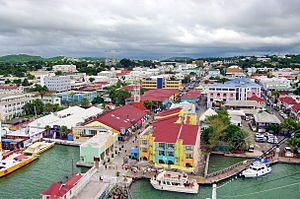 | |
| Currency | East Caribbean dollar (XCD) |
|---|---|
| 1 April - 31 March | |
Trade organisations | WTO, CARICOM |
| Statistics | |
| GDP | |
| GDP rank | 176th (nominal) / 179th (PPP) |
GDP growth |
|
GDP per capita | |
GDP by sector | agriculture: 2.1%, industry: 19.6%, services: 78.3% (2012) |
| 5.067% (2023)[1] | |
Population below poverty line | no data |
Labour force | 30,000 (1991) |
Labour force by occupation | agriculture: 7%, industry: 11%, services: 82% (1983) |
| Unemployment | 11% (2001 est.) |
Main industries | tourism, construction, light manufacturing (clothing, alcohol, household appliances) |
| External | |
| Exports | $37.9 million (2012 est.) |
Export goods | petroleum products, bedding, handicrafts, electronic components, transport equipment, food and live animals |
Main export partners |
|
Import goods | food and live animals, machinery and transport equipment, manufactures, chemicals, oil |
Main import partners |
|
| Public finances | |
| $458 million (June 2010) | |
| Revenues | $229.5 million (2009) |
| Expenses | $293.4 million (2009) |
| Economic aid | recipient: $2.3 million (1995) |
All values, unless otherwise stated, are in US dollars. | |
The economy of Antigua and Barbuda is service-based, with tourism and government services representing the key sources of employment and income. Tourism accounts directly or indirectly for more than half of GDP and is also the principal earner of foreign exchange in Antigua and Barbuda. However, a series of violent hurricanes since 1995 resulted in serious damage to tourist infrastructure and periods of sharp reductions in visitor numbers. In 1999 the budding offshore financial sector was seriously hurt by financial sanctions imposed by the United States and United Kingdom as a result of the loosening of its money-laundering controls. The government has made efforts to comply with international demands in order to get the sanctions lifted. The dual island nation's agricultural production is mainly directed to the domestic market; the sector is constrained by the limited water supply and labor shortages that reflect the pull of higher wages in tourism and construction. Manufacturing comprises enclave-type assembly for export with major products being bedding, handicrafts, and electronic components. Prospects for economic growth in the medium term will continue to depend on income growth in the industrialized world, especially in the US, which accounts for about one-third of all tourist arrivals. Estimated overall economic growth for 2000 was 2.5%. Inflation has trended down going from above 2 percent in the 1995-99 period and estimated at 0 percent in 2000.
To lessen its vulnerability to natural disasters, Antigua has been diversifying its economy. Transportation, communications and financial services are becoming important.
Antigua is a member of the Eastern Caribbean Currency Union (ECCU). The Eastern Caribbean Central Bank (ECCB) issues a common currency (the East Caribbean dollar) for all members of the ECCU. The ECCB also manages monetary policy, and regulates and supervises commercial banking activities in its member countries.
Antigua and Barbuda is a beneficiary of the U.S. Caribbean Basin Initiative. Its 1998 exports to the U.S. were valued at about US $3 million and its U.S. imports totaled about US $84 million. It also belongs to the predominantly English-speaking Caribbean Community (CARICOM).
- ^ a b c d e f "World Economic Outlook Database, April 2024". IMF.org. International Monetary Fund. Retrieved 20 June 2024.
- ^ "Export Partners of Antigua and Barbuda". The Observatory of Economic Complexity. Retrieved 8 March 2024.
- ^ "Import Partners of Antigua and Barbuda". The Observatory of Economic Complexity. Retrieved 8 March 2024.